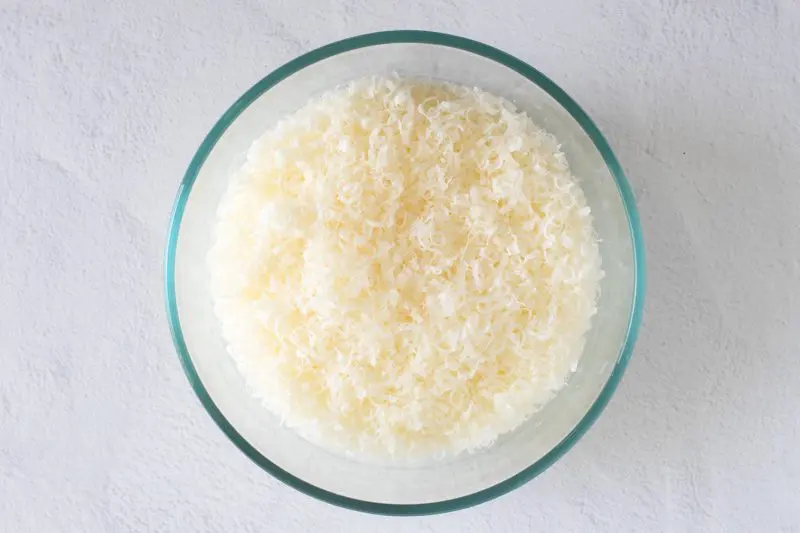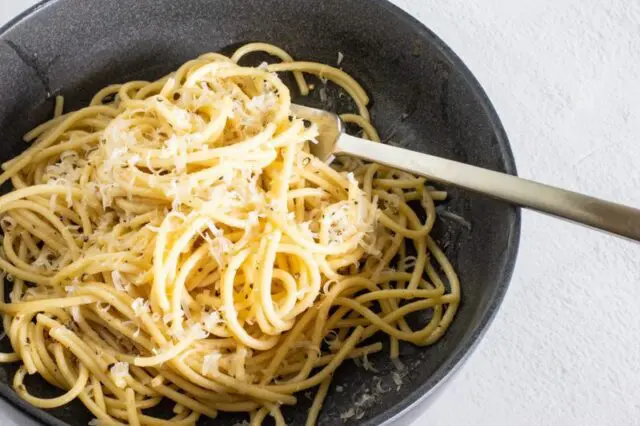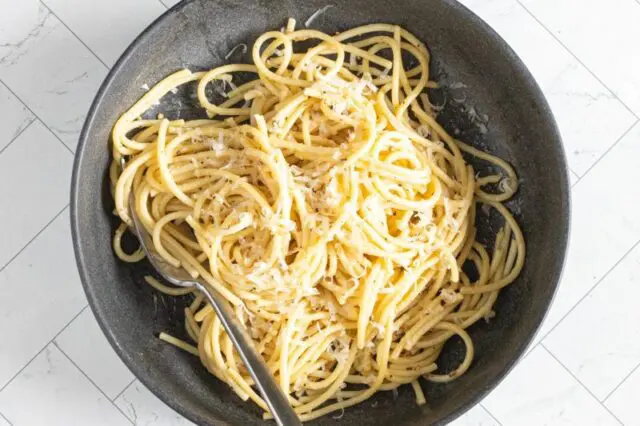Cacio e pepe is Roman pasta dish that literally means “cheese and pepper.” It’s a simple dish made with long pasta, Pecorino Romano and a healthy amount of coarsely ground black pepper. This version includes some butter and olive oil, but if you want to be truly authentic, use only spaghetti, coarsely ground pepper, pecorino, and enough salted pasta cooking water to make a creamy sauce.
Pecorino is traditional for authentic cacio e pepe pasta, but a combination of Pecorino and Grana Padano is a nice alternative, or use Parmesan with the Pecorino. Pecorino is a sheep’s milk cheese—it is a bit stronger and sharper than a good quality Parmesan cheese. Grana Padano is slightly sweeter than the Pecorino, but it is similar enough in texture and flavor to be a suitable substitute.

Is Parmesan Cheese Similar to Pecorino?
While the flavor and texture of Parmesan cheese are similar to Pecorino, there are some differences. Parmesan cheese is made with cow’s milk and pecorino is made with sheep’s milk. Pecorino is also saltier and a bit sharper than Parmesan. If you have no other options, the cacio e pepe will be delicious with a good quality grated Parmesan cheese.
Since the texture and flavor of cacio e pepe pasta depends largely on the cheese, use a good quality pecorino Romano, and grate it by hand. A microplane grater—the same one you use to zest your citrus—is ideal for shredding the into fine, fluffy bits that melt into the pasta quickly and flawlessly. The hot pasta water turns the cheese into a clinging sauce you have to taste to believe.
Feel free to make some changes or additions. If you like a little heat, add a pinch of crushed red pepper flakes or a dash of dried Calabrian chile flakes. Or stir a handful of sliced cherry tomatoes and sliced basil into the pasta just before serving for a bright, fresh finish. I love this dish with regular spaghetti, but it would work beautifully with thin spaghetti, bucatini, or just about any long pasta.
Serve cacio e pepe with toasted garlic bread or focaccia and a Caesar salad or tossed salad. It’s satisfying enough to be the main dish, but it can be a side dish as well. Serve alongside these sheet pan Italian sausages and peppers, chicken marsala, or Instant Pot chicken with sundried tomatoes.

How to Store and Reheat Leftover Cacio e Pepe
- Refrigerate leftover cacio e pepe within 2 hours and eat within 4 days.
- To reheat, transfer the cacio e pepe to a skillet or saucepan with a small amount of water. Heat gently over low heat while stirring constantly until hot. Serve with extra grated pecorino cheese.
Cacio e Pepe Recipe
Cacio e pepe seems too simple to be good, but it is delicious! Pecorino Romano cheese for the most authentic version of the traditional pasta.
- Prep Time: 8 minutes
- Cook Time: 12 minutes
- Total Time: 20 minutes
- Yield: 3 to 4 servings 1x
- Category: Pasta
- Cuisine: Italian
Ingredients
- 4 tablespoons olive oil, divided
- 1 teaspoon freshly ground black pepper, slightly coarse
- 8 ounces spaghetti, bucatini, or similar long pasta
- 2 teaspoons salt, for the cooking water, plus more for seasoning, as needed
- 2 tablespoons unsalted butter
- 2 ounces Pecorino Romano, finely grated
- 4 to 5 tablespoons of hot pasta cooking water
Instructions
- Put the olive oil and black pepper in a sauté pan or deep skillet and place it over medium-low heat. Heat the mixture for 2 minutes; remove from the heat and set aside.
- Bring about 3 quarts of water to a boil. Add 2 teaspoons of salt and the pasta. Cook following the package instructions for al dente pasta. Remove about 1/2 cup of the pasta water and drain the pasta in a colander.
- Place the pan with the olive oil and pepper over low heat. Add the butter and hot drained spaghetti and stir to coat. Stir in the grated cheese and about 4 to 5 tablespoons of the hot pasta cooking water. Stir until the cheese mixture is creamy and coats the pasta. Taste and adjust the seasonings with more salt and pepper, as needed.
- Serve in pasta bowls with extra grated cheese.

